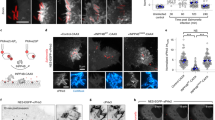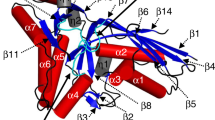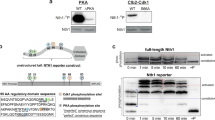Abstract
ALTHOUGH myo-inositol hexakisphosphate (InsP6; phytate) is the most abundant inositol phosphate in nature1 and probably has a wide variety of functions2–8, neither the route of its synthesis from myo-inositol nor its metabolic relationships with other inositol-containing compounds (such as the second messenger inositol 1,4,5-trisphosphate, Ins(l,4,5)P3) are known9. Here we report that the pathway by which InsP6 is synthesized in the cellular slime mould Dictyostelium, and in cell-free preparations derived from them, is catalysed by a series of soluble ATP-dependent kinases independently of the metabolism of both phosphatidylinositol and Ins(l,4,5)P3 (refs 10,11). The intermediates between myo-inositol and InsP6 are Ins3P, Ins(3,6)P2, Ins(3,4,6)P3, Ins(l,3,4,6)P4 and Ins(l,3,4,5,6)P5. The 3- and 5-phosphates of InsP6 take part in futile cycles in which Ins(l,2,4,5,6)P5 and Ins(l,2,3,4,6)P5 are rapidly formed by dephosphorylation of InsP6, only to be rephosphorylated to yield their precursor.
This is a preview of subscription content, access via your institution
Access options
Subscribe to this journal
Receive 51 print issues and online access
$199.00 per year
only $3.90 per issue
Buy this article
- Purchase on Springer Link
- Instant access to full article PDF
Prices may be subject to local taxes which are calculated during checkout
Similar content being viewed by others
References
Cosgrove, D. J. Inositol Phosphates (Elsevier, Amsterdam, 1980).
Vallejo, M., Jackson, T., Lightman, S. & Hanley, M. R. Nature 330, 656–658 (1987).
Nicoletti, F., Bruno, V., Fione, L., Vavalloro, S. & Canonico, P. L. J. Neurochem. 53, 1026–1030 (1989).
Barraco, R. A., Phyllis, J. W. & Simpson, L. L. Eur. J. Pharmac. 173, 75–84 (1989).
Graf, E., Mahoney, J. R., Bryant, R. G. & Eaton, J. W. J. biol. Chem. 259, 3620–3624 (1987).
Williams, S. G. Pl. Physiol. 45, 376–381 (1970).
Biswas, S., Maity, I. B., Chakrabarti, S. & Biswas, B. B. Arch. biochim. biophys. Acta 185, 557–566 (1978).
Biswas, S. & Biswas, B. B. Biochim. biophys. Acta 108, 710–713 (1965).
Berridge, M. J. & Irvine, R. F. Nature 341, 197–205 (1989).
Shears, S. B. Biochem. J. 260, 313–324 (1989).
Van Haastert, P. J. M. et al. Biochem. J. 258, 577–586 (1989).
Martin, J., Foray, M., Klein, G. & Satre, M. Biochim. biophys. Acta 931, 16–25 (1987).
Europe-Finner, G. N. et al. J. Cell Sci. 89, 13–20 (1988).
Stephens, L. R. in Methods in Inositide Research (ed. Irvine, R. F.) (Raven, New York, in the press).
Stephens, L. R., Hawkins, P. T., Barker, C. J. & Downes, C. P. Biochem. J. 253, 721–723 (1988).
French, P. J., Bunce, C. M., Brown, G., Creba, J. A. & Michell, R. H. Biochem. Soc. Trans. 16, 985–986 (1988).
Szwergold, B. S., Graham, R. A. & Brown, T. R. Biochem. biophys. Res. Commun. 149, 874–881 (1987).
Kay, R. R. & Trevan, D. J. J. Embryol. exp. Morph. 62, 369–378 (1981).
Das, O. P. & Henderson, E. J. Biochem. biophys. Acta 736, 45–65 (1983).
Stephens, L. R. & Downes, C. P. Biochem. J. 265, 435–452 (1990).
Maslanski, J. & Busa, W. B. in Methods in Inositide Research (ed. Irvine, R. F.) (Raven, New York, in the press).
Author information
Authors and Affiliations
Rights and permissions
About this article
Cite this article
Stephens, L., Irvine, R. Stepwise phosphorylation of myo-inositol leading to myo-inositol hexakisphosphate in Dictyostelium. Nature 346, 580–583 (1990). https://doi.org/10.1038/346580a0
Received:
Accepted:
Published:
Issue Date:
DOI: https://doi.org/10.1038/346580a0
This article is cited by
-
Role of inositol polyphosphates in programed cell death in Dictyostelium discoideum and its developmental life cycle
Molecular and Cellular Biochemistry (2018)
-
Simple synthesis of 32P-labelled inositol hexakisphosphates for study of phosphate transformations
Plant and Soil (2018)
-
Importance of Radioactive Labelling to Elucidate Inositol Polyphosphate Signalling
Topics in Current Chemistry (2017)
-
Molecular and biochemical identification of inositol 1,3,4,5,6-pentakisphosphate 2-kinase encoding mRNA variants in castor bean (Ricinus communis L.) seeds
Planta (2014)
-
Identification of genes necessary for wild-type levels of seed phytic acid in Arabidopsis thaliana using a reverse genetics approach
Molecular Genetics and Genomics (2011)
Comments
By submitting a comment you agree to abide by our Terms and Community Guidelines. If you find something abusive or that does not comply with our terms or guidelines please flag it as inappropriate.



